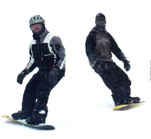THE ADVANCED SNOWBOARD LESSON
by
Chuck Roberts
1. Introduce yourself to the students, ask names, be friendly, ask student how long they have been riding, how many lessons they have had. Make sure your stu-dent belongs in the advanced class. (Ask what runs they have been riding on, how comfortable they are with their turns, etc.)
2. Present goal of the advanced lesson (link carved turns of varying shape / half pipe, terrain park). Remember the acronym, WWWWH: WHO - advanced rider, WHAT-advanced lesson, WHY-learn to ride all terrain, WHERE-advanced terrain, HOW-by explanation, demonstration, participation, practice.
3. Take students for a ride down intermediate terrain to assess students' abilities.
4. Make the transition from skidded turns to carving turns:
a) Carving exercises: steep traverse, uphill christies.
b) Help edging skills with hip and knee angulation. Make "good' angles with the snow; encourage incli-nation as well as angulation.
c) Angulation exercises: "touch" the bottom of the board during a turn, vary knee and hip flexion to ac-complish angulation, commit center of mass to the new turn, hands in front and to the inside of the turn.
d) Pre-bend the board by moving knees together for shorter radius turns. Experience the stored energy in the bent board that helps initiate the next turn.
e) Perform long radius turns (arcing) where the upper body crosses over the board and the center of mass moves to the inside of the turn.
f) Perform cross-under turns (short radius) where the upper body is relatively stable and the lower body does all the work.
g) Turns should be continuous with no interruptions. (i.e. linked with no traverse)
h) Vary toe and heel side pressure during a turn to ex-perience the effect of torsional board deflection on the turn.
i) Ride switch stance (fakie) on varying terrain
5. Half pipe lesson:
a) Prepare for half pipe by riding switch stance, practic-ing on-snow 180 degree turns, 360 degree turns and elementary 180 degree jumps from regular riding to switch and back again. Ride near edge of trails and practice on 1/4 pipes.
b) Check out student in half pipe by performing falling leaf back and forth up the side walls of the half pipe all the way to the end. Perform skidded linked turns across the half pipe and up the transition.
c) When riding up the transition wall of a half pipe, the student should be in a completely flexed stance. The student then extends at the lip of the vertical wall in order to get sufficient air to perform a maneuver and land back in the half pipe. If your students do not flex before the jump, they will not get sufficient air and will land outside the half pipe area. Initiate the air turn using the upper body. Significant rotary move-ment is required for air turns. Keep center of mass over the board while getting air to assure control and a proper landing.
6. Fun box lesson
a) On a beginner slope, practice riding on a straight line drawn in the snow down the fall line. The student must line up properly to go over the box.
b) Start slowly over the entry of the box in a flexed posi-tion. The instructor can assist the student by holding hands.
c) Have the student look at the end of the box for proper alignment and ride right down the fall line in a proper, non twisted stance.
7. Rail lesson
a) On a beginner slope, practice riding on a straight line drawn in the snow down the fall line. The student must line up properly to ride a rail.
b) Start slowly over the entry of the rail in a flexed posi-tion. The instructor can assist the student by holding hands.
c) Have the student look at the end of the rail for proper alignment and ride right down the fall line in a proper, non twisted stance.
d) Ollie off the end of the rail.
8. Jumping lesson
a) Start with proper body position, no twist.
b) Ride over small mogul jumps, get air and land in di-rection of travel.
c) Ride up beginning table top, keep neutral stance, after launching from the kicker, flex ankles and knees (suck up your feet) to look cool and get more air, extend for landing and absorb the landing with bent knees. Do not twist unless you expect to spin.
9. Conclude lesson, recap what was learned, were goals accomplished, get feedback. Tell students what to ex-pect in the next lesson, sell the next lesson.
 BACK TO ROBERTS SKI AND SNOWBOARD INSTRUCTION HOME PAGE
BACK TO ROBERTS SKI AND SNOWBOARD INSTRUCTION HOME PAGE
 BACK TO ROBERTS SKI AND SNOWBOARD INSTRUCTION HOME PAGE
BACK TO ROBERTS SKI AND SNOWBOARD INSTRUCTION HOME PAGE